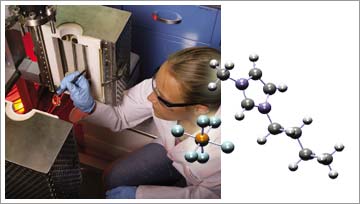Capturing Greenhouse Gases

Researchers are using a combination of atomistic simulations and
targeted experiments to develop a working prototype absorption unit.
A graphic of an ionic liquid ion pair, captured from one of their
simulations is pictured above.
Given that President Bush’s
Global Climate Change Initiative calls for an 18 percent reduction
in the nation’s greenhouse gas production by 2012, it is not
surprising that the Department of Energy (DOE) has been placing an
emphasis on the development of clean coal technologies. Nor is it
surprising that the DOE wants to be able to use the country’s
abundant sources of coal — up to 400 years worth of coal (energy) — in
a more environmentally responsible way, limiting greenhouse gases
and lowering the nation’s dependence on foreign oil supplies.
The truth is that the capture of carbon dioxide (CO2) from combustion
exhausts is one of the areas in which the DOE has expanded its efforts.
And, on October 23, the DOE announced the distribution of grants
through the Carbon Sequestration Program totaling nearly $24 million
for the development of novel and cost-effective technologies to capture
CO2. Notre Dame received $3 million.
Led by Edward
J. Maginn, professor of chemical and biomolecular engineering; Joan
F. Brennecke, the Keating-Crawford Professor of Chemical
and Biomolecular Engineering and Director of the Notre Dame Energy
Center; and William F. Schneider, associate
professor of chemical and biomolecular engineering, the goal
of the Notre Dame project is to exploit the unique properties
of ionic liquids and develop solvents for the post-combustion
capture of CO2. This technology has the potential of being used
in existing absorption processes, as well as with membrane processes.
Capturing
CO2 from combustion exhausts is not a new concept to University researchers.
Two years ago a team led by Maginn and Brennecke demonstrated that
ionic liquids have the potential to efficiently capture CO2 from
the flue gas of coal-fired power plants.
There are
a variety of ways to remove CO2 from emissions (and the air), including
pre-combustion, post-combustion, and oxycombustion. Notre Dame is
focusing its efforts on post-combustion processes, which involves
capturing CO2 after fuel has been combusted in air. University partners
in this area are Babcock and Wilcox, an international energy services
company based in Baberton, Ohio; Darmstadt, Germany’s Merck KGaA,
the oldest pharmaceutical and chemical company in the world; DTE Energy, a national
diversified energy company based in Detroit, Mich.; and the Buda, Texas based
Trimeric Corporation, which provides process engineering, chemical engineering,
research and development, and a variety of services to the public and private
sectors.
For more information
on this project and other energy-related research, visit the Notre
Dame Energy Center at http://energycenter.nd.edu. |


